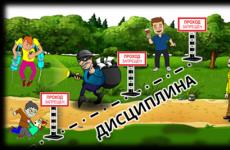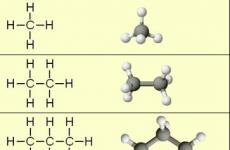How to act when evacuating from the building. The procedure for the evacuation of people in the fire
Evacuation in the fire
Timely and competent organized evacuation Fire people are one of the main events that are necessary when the fire has arisen, especially at facilities with a large number of crowds of people.
There are cases when even in case of insignificant lighting of individual people, exaggerating the danger, rushed to the outputs with screams, causing general confusion. This led to a crust, injuries of people, and sometimes even to death. Sometimes during the fire people, fleeing from the fire, left, left open doorsAnd the flame quickly spread through the doorways, covered all new premises.In some fires, people tried to go through the premises covered by fire without defending themselves from exposure high temperatures. In such cases, even one inhale of the hot air led to a paralysis of the respiratory tragic outcome. Passing through the fire, people received heavy burns.
As practice shows, the individual and collective behavior of people in the fires is largely determined by the fear caused by the awareness of the danger. Strong nervous excitement mobilizes physical resources: energy is added, physical force increases, the ability to overcome obstacles increases. But at the same time, the ability to adequately perceive the situation in the evacuation process. In this state, the suggestibility of people becomes sharply increasing, the actions of the people become automatic, the incontinuations are stronger. In such situations, if there is no clear guidance to evacuation, panic and crush may occur. People can forget about the availability of spare outlets intended for evacuation in the fire.
In buildings and facilities (except for residential buildings), with a one-time finding on the floor, more than 10 people should be developed and in prominent places plans (schemes) of the evacuation of people in the event of a fire, and the system (installation) of the alert of people about the fire is provided.
At objects S. mass stay people (50 or more people) In addition to the schematic plan for the evacuation of people in a fire, an instruction should be developed that determines the actions of the personnel to ensure safe and fast evacuation people who are at least once in half of the year should be held practical training All workers involved for evacuation.
For objects with night stay of people (kindergartens, boarding schools, hospitals) in the instructions should provide for two options for action: in the day and at night.
The leaders of the specified objects daily in the established state fire service (hereinafter - GPS) Time is reported to fire Piece, in the area of \u200b\u200bleaving the object there is an object, information on the number of people located on each object.
The head of the organization or replacing his employee who arrived at the Evacuation Place and Fire Frame:
Check if a fire was reported on fire;
To manage the evacuation of people and fire extinguishing before the arrival of fire units. In the event of a threat to the life of people, immediately organize their salvation using all available forces and means for this;
Organize checking for children and workers evacuated from the building, on the existing lists and class journals;
To allocate a person who knows the location of the driveway and water sources to meet fire units;
Check the inclusion in the operation of an automatic (stationary) system of fire extinguishing;
Remove from the danger zone of all employees and other persons who are not engaged in the evacuation of people and fire elimination;
If necessary, to cause medical and other services to the place of fire;
Stop all work that are not related to evacuation activities of people and fire elimination;
Organize the disconnection of electrical and gas supply networks, stopping the ventilation and air conditioning systems and the implementation of other activities that contribute to the prevention of fire distribution;
Ensure the safety of people participating in evacuation and fire extinguishing, from possible collaborations of structures, the effects of toxic combustion products and elevated temperatures, lesions electric shock etc.;
Organize the evacuation of material values \u200b\u200bfrom the danger zone, to identify the places of their storage and ensure, if necessary, their protection;
Inform the head of the fire unit about the availability of people in the building.
When conducting evacuation and fire extinguishing:
Taking into account the established situation, determine the safest evacuation paths and exits that ensure the possibility of evacuating people into a secure zone as soon as possible;
Exclude the conditions contributing to the occurrence of panic. To this end, teachers, teachers, educators, and other employees educational institution It is impossible to leave children unattended from the moment of detection of the fire and before its elimination;
The evacuation of children should be started out of the room in which there was a fire and related premises with it, which threatens the danger of spreading fire and combustion products. Children younger age and patients should be evacuated first;
IN winter time, at the discretion of evacuation persons, children of senior age groups can pre-dress or take warm clothes with themselves, and younger children should withdraw or endure, wrapped in blankets or other warm things;
Carefully check all the rooms to eliminate the possibility of staying in the danger zone of children hidden under beds, parties, in closets or other places;
Putting posts security at the outputs to the building to exclude the possibility of returning children and workers to the building where the fire originated;
In carrying out, it should be striving first of all to ensure favorable conditions for evacuation in the fire
Refrain from opening windows and doors, as well as from breaking glass in order to avoid the spread of fire and smoke in related premises. Leaving the room or building, you should close all the doors and windows.
Heads of organizations on the territory of which are used, recycled and stored dangerous (explosive) potent poisonous substances should be reported to divisions. fireguard Data on them necessary to ensure the safety of the personnel involved in extinguishing the fire and conducting priority rescue work in these enterprises.
Upon arrival of the fire department, the head of the Organization (or his face, its replacement) informs the head of the extinguishing fire on constructive and technological features object adjacent buildings and structures, quantities and fire hazardous properties stored and used substances, materials, products and other information necessary for successful fire elimination, as well as organizes attracting forces and means of the facility to implement the necessary measures related to fire elimination and the prevention of its development.
Materials
Actions in case of fire in a residential building.
Observe calm.
Call on page 01 or 112 and cause firefighters and rescuers. Call to number 112 is possible with mobile phone Even in the absence of a SIM card. You must specify the exact address and floor and, if possible, meet them.
Disable all electrical appliances with a chopper in the corridor and gas in the kitchen. If the TV caught fire: disconnect from the network and cover it with a wet bedspread.
Close windows and doors to remove oxygen access for burning.
At the initial stage, you can try to repay the fire yourself: it is best to use the fire extinguisher. Or tightly cover the focus of fire to the cloth, fall asleep the earth, if it is not oil - pour water. With failure - to start evacuation.
Take young children in the hands and take them out of the room, help the elderly, to assist the victims.
Quickly get out of the fire zone, attaching a safe route in advance. Do not use the elevator! If necessary, use spare fires and stairs.
You need only documents and money, valuable things that can be carried at one time.
Be sure to use the simplest means of protecting the respiratory organs from carbon monoxide: Water moistened with scarves, cotton-gauze bandages.
With a strong smoke, move Clarice to the exit, since the bottom of the floor smoke is smaller and below the likelihood of losing consciousness.
Leaving entrance door on the key.
If it is impossible to leave the room, try to draw attention to: knock out the window, shout and wave a bright cloth.
Calculation of evacuation paths.
The purpose of calculating evacuation paths is to verify the compliance of the sizes of evacuation pathways and the outputs of safety requirements. Security criteria are the timeliness of evacuation and unhindered.
The calculation is usually made in the following order.
1. The overall setting of the problem is determined, for example, providing a given time of movement of people or densities of human streams, which is associated with trauma emergency.
2. The calculated number of people is determined.
3. The most likely ways of movement of people are selected, which represents a rather complicated task, since there are no objective methods yet. Here it is necessary to consider the following. People try to move to wider and well-visible outputs, use familiar routes.
4. The sizes of communication paths are determined.
5. Calculation of the motion parameters of people. Currently, formulas GOST 12.1.004-91 * are used to calculate the evacuation paths (in special cases - MGSH 4.19-2005.
6. The results obtained are analyzed. Previously, the compliance of the results of the calculation of the allowable values \u200b\u200bof the evacuation time and density is checked. If the specified parameters turned out to be exceeded, the places in which people were formed, the movement occurs too slowly, and the density human Flood high. In these places, it follows the expansion of the relevant sites to ensure such a course of the evacuation process, which would have responded to the specified conditions. Analysis of the parameters of communication premises is made according to the results of the calculation, both in an emergency and in normal conditions.
Evacuation is achieved by independent movement of people outside of the danger zone, as well as the unhapping of people who belong to small groups of the population, which is carried out by attendants and other people.
Features and motion parameters of people during evacuation
Evacuation of people in case of fire
The movement of people takes place in all premises of buildings and structures that are associated with the residence of a person. For these purposes, communication premises and other special devices are provided in the buildings: entrances and exits, corridors, staircase, lobby, lobby, passages, and the like. Communication premises can occupy a sufficiently significant area, which adds in some cases excess of 30% of the working area of \u200b\u200bthe building.
Of particular importance is the movement of people in the event of a fire in the building, since there is a real threat to their life and health.
Forced process of moving people from a zone where possible effect on them dangerous factors Fire, called evacuation.
Rescue is forced movement of people outside with the influence of dangerous fire factors on them or when the immediate threat has occurred .
Rescue is carried out independently, with the help of fire units or specially trained personnel.
In case of fire, the evacuation process begins almost simultaneously and has a clear orientation - everyone is sent to the outputs. As a result of such a simultaneous and oriented movement and, as a result of the limited bandwidth of evacuation pathways and outputs, large densities of human flows are formed, individual evacuated begin to apply physical efforts, which significantly reduces the speed of the overall movement. Thus, the situation occurs when faster people They seek to leave the room (building), the slower it takes place.
The psychology of the individual and collective behavior of people in fire is largely determined by the fear caused by the realization of real danger. Strong nervous excitement actively mobilizes the physical resources of a person, however, there is a narrowing of consciousness, the ability to objectively realize the situation in full, since attention is fully paid to events that take place. Under the influence of stressful state, suggestion is growing, the teams are perceived without the appropriate
lisa and estimates, the actions of people become inadequate circumstances that have developed. Panic reactions turn out to be mainly in the form of a stupor (fading, immobility, inability to action) or fugues (chaotic casting, running, surface orientation in circumstances). The bulk of people who are evacuated during a fire is capable of an objective assessment of the situation and reasonable actions, however, feeling fear and infecting them each other may be a panic.
People who move in one direction create a human stream. Movement of people in the stream is characterized flow density d, velocity V, the intensity of the Q and throughput Pattern of Q.
The density of the human stream is the initial characteristic, which allows to determine the speed and intensity of the movement. It is defined as the number of people N, which is placed on the unit of the area of \u200b\u200bthe evacuation path F:
With an increase in the flux density, the speed of movement is reduced and at d \u003d 9 people · m 2 for horizontal portions of the path does not exceed 15 m · min. During the evacuation of adults, the density may be 10-12 people · m 2; When evacuating schoolchildren - 20-25 people · m 2.
The speed of movement of people in the stream depends on the type of path (horizontal path; the staircase of the book; the staircase upstairs; the slot) and the density of the human stream.
The intensity of motion (specific bandwidth) characterizes the number of people who pass through 1 m wide widths or passage per unit of time, and also depends on the density of the flow.
Evacuation of people from buildings and structures is carried out in terms of evacuation paths through evacuation outputs.
Evacuation path - safe for the movement of people the path that leads to the evacuation exit.
EMERGENCY EXIT - this is a way out of the house (facilities), directly outward or out of the room, which leads outside, to the corridor or staircase directly or through the adjacent room.
Outputs are considered evacuation if they are conducted from the premises:
The first floor directly outward or through the corridor, the vestibule, the staircase;
Any floor, except for the first, to the corridor, which leads to the staircase or directly into the staircase (including through the hall). At the same time, stair cells must have a way out directly or through the lobby that separated from the adjacent corridors by partitions with doors;
to the next room on the same floor, which is provided already mentioned outputs.
With arrangement evacuation outlets Of the two staircases through the common lobby, one of the staircases except the exit to the vestibule should have a way out directly out.
Outputs are allowed to be provided through the tambura.
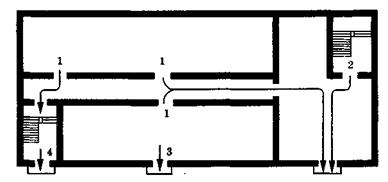
Fig. 7.3. Evacuation exits from the first floor premises:
1 - exit from the room in the corridor, which leads through the vestibule or staircase directly outwardly; 2 - exit from the staircase through the vestibule outward; 3 - exit from the room directly out; 4 - exit from the staircase directly outward
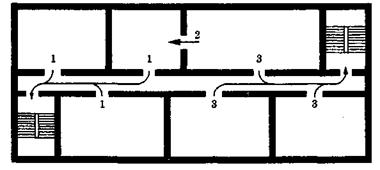
Fig. 7.4. Evacuation exits from the premises of the second floor and above the following floors:
1 - exit from the room in the corridor, which leads to a stairwell, which has directly outgoing; 2 - Exit to neighboring room; 3 - Exit from the room in the corridor, which leads to a staircase, which has an output through a vestibule, separated from the corridor with a partition with doors
Evacuation outputs should be dispersed. The minimum distance l between the most distant one from the other evacuation outlets from the room can be determined by the formula
where n is the perimeter of the room.
Achieving the normal rhythm of movement is ensured by the fulfillment of the requirements for the amount, size and placement of evacuation pathways and outputs, the exclusion of obstacles (thresholds, narrowings, cutting sites, and the like) on the evacuation paths, compliance with the requirements relative to the direction of disagree.
The width of evacuation outputs also affects the evacuation process and in some cases can cause a delay in motion.
The main routes of evacuation from buildings are corridors and a staircase.
The width and length of the corridor should provide the necessary speed of passing people who are evacuated to the staircase or outward. People who are evacuated must see outdoor outlets. For this door, the output doors must be marked with light poins with the outpatch "Exit" in cases determined by the norms, or indicable signs that are established by standards.
The only ways of evacuation that connect all the floors, except for the first, with immediate exits outside the building, is a staircase. Therefore, they must have a convenient connection with the floors and at the same time reliable isolation from them, which eliminates the effect on people of dangerous fire factors. This is achieved by the arrangement of the ladder itself in special staircases with fire-resistant enclosures and carriage structureswhich are made of non-combustible materials. Staircases are isolated from basements and attic.
When evacuating the stairs, a normal rhythm of movement should be provided. Therefore, as evacuation is not allowed to use screw staircase, as well as the staircase that has the width of the stages of unequal and does not provide resistance during the movement, the stair marches are performed with the same lengths and slopes. It is especially important to ensure the unobstructed evacuation of people on the stairs. Real obstacles can be: equipment that stands for the plane of walls at an altitude of up to 2.2 m from the surface of the offshore and stairs sites; insufficient passage; Local narrowings on the staircases and the outlet of the staircase. Great importance It also has lighting of staircases, which is executed, as a rule, natural through windows in external wallsWhat is needed not only to ensure evacuation, but also for ventilating in case of smoke. Therefore, the arrangement of the so-called "dark" staircases, which do not have natural lighting, is undesirable and allowed in exceptional cases when they are satisfied with reliable anti-enemy protection.
In some cases, if the bandwidth and length of sufficiently single evacuation exit is allowed as a second (from the above-located floors) to access the outer evacuation staircase.
For open facilities industrial enterprises (external shelf, platforms, etc.) The external staircase is often the main ways of evacuation.
The outer evacuation staircase should be made from non-combustible materials. They must communicate with rooms through platforms or balconies arranged at the level of evacuation outputs. The bowing of such a staircase should be no more than 1: 1 (45 °), and their width is at least 0.7 m. The external staircase should reach the level of land and the mother fence.
To create and ensure the safety conditions of people in a fire on the Evacuation paths, it is not allowed:
Arrange thresholds, performances and any devices that impede the free evacuation of people;
Close (corridors, passages, stair Machi. and platforms, vestibulі, halls, tamburas and the like furniture, equipment, materials and finished productseven if they do not reduce the regulatory width;
Scold, brew, lock on mounted locks, bolt connections and other constipation that are difficult to reveal from the inside, external evacuation doors of buildings;
Apply (except for buildings V degree of fire resistance) combustible materials for wall cladding and ceilings, as well as stairs and staircases;
To have exits in Tamburas, with the exception of apartments and individual residential buildings, wardrobes, clothes hangers, fit them for trading, as well as store, including temporarily, any inventory and material;
Close up furniture, equipment and other doors, hatches on balconies and loggias, transitions to adjacent sections and outputs to an external evacuation staircase;
Shoot installed on balconies (loggias) stepladders;
Arrange the room in the stairwell, in T.O. kiosks, lots, as well as exits from freight elevators (lifts), laying industrial gas pipelines, pipelines from LZR and GR, R.Trovodi;
Arrange storage and built-in cabinets in common corridors, with the exception of cabinets for engineering communications; Store in cabinets (niches) for engineering communications combustible materials, as well as other foreign objects;
Place B. lift Halls storerooms, kiosks, sillings, etc.;
Installing cameras in the aisles in such a way that they prevent the evacuation of people;
Make a rumble or laying the stuffy and holes of the air zones in unseasonable staircases;
To shoot the door foreseen by the door of the lobby, halls, tambours and staircases;
Reinforced glass on the usual in the doorway and framugs, contrary to the project foreseen;
Remove the device for self-charging door of stair cells, corridors, holls, tambouries and the like, and also fix the self-sharp doors in open position;
Reduce the regulatory area of \u200b\u200bFramug in the external walls of the stairwells or lay them out;
Hang on the walls in the staircases of stands, panels and the like.
In case of disconnection of electricity in buildings with a mass stay of people, the staff must have electric lights.
Attendant hotel staff and hotel complexes with the number of places for accommodation 50 and should be provided individual means Protection of respiratory authorities for organizing evacuation in the event of a fire.
Carpets, carpet tracks (coating) in rooms with a massive stay of people should be securely attached to the floor and be low hazard relative to the toxicity of combustion products, as well as have a moderate smoke-forming ability.
The desired length of evacuation paths is determined in accordance with the current construction norms and regulations, and their actual length - on the project or on a real object. It is necessary to take into account some features of normalization of the length of evacuation paths. IN public buildings The limit distances in the premises are normalized, as well as the length of the evacuation paths from the door of the room to the nearest output outside or on the staircase cell. In the production buildings of the corridor type, the power of evacuation paths is normalized from the most distant workplace to the output outside or on the staircase (the length of the path indoors and the path along the corridor are summarized). This is due to characteristic production buildings The rapid spread of the fire and the smoke of evacuation paths. When used in the building of an open staircase, the actual length of evacuation paths is measured from the most distant workplace to the output outward.
Performance regulatory requirements Regarding evacuation routes, it does not guarantee the complete success of the evacuation of people in the event of a fire. Technical solutions and regime firefire events In this direction should be supplemented organizational events (briefing and studying personnel, mapping responsibilities for ensuring fire safety In the instructions and other documents). To ensure organized movement during the evacuation and prevention of panic, develop evacuation plans from buildings and places with a massive stay of people.
The evacuation plan consists of two parts: graphic and textual. The grafical part It is a floor plan or room plan, which can be simplified, depicting designs in one line, excluding small rooms that are not associated with the stay of people. However, all evacuation
exits and paths must be designated. Names of premises are marked directly on the plan or number. For simplification explanatory notes The plan needs to numbered evacuation exits and stairs. Doors are depicted in the open form.
During the folding of such plans, evacuation exits are divided into basic (reliable and coming) and reserve, or reserve (less reliable and more distant).
Motion routes to the main evacuation outputs are depicted with solid lines with green arrow, and routes to spare evacuation outputs are dotted green lines with arrows.
In addition to routes of movement, the Plan reflects the locations of the alert and fire extinguishing. The main graphic symbols that are used in the evacuation plans shown in Table. 7.3.
Every year, more than 140,000 fires occur in Russia, on which tens of thousands of people die. For poor quality compliance fire-fighting regime Employers pay health, and sometimes and the lives of their employees. What do you need for safe evacuation In case of fire?
Measures to evacuate people in the fire
Every year, more than 140,000 fires occur in Russia, on which tens of thousands of people die. This situation was due to the fact that separate objects Fire safety is not provided. Employers are constantly fulfilling the requirements of the Federal Law of December 21, 1994 No. 69-FZ "On Fire Safety" and the rules of fire regime in Russia 1. In these documents, as well as Federal Law Of July 22, 2008 No. 123-FZ "Technical Regulations on Fire Safety Requirements" special attention It is paid to ways to protect people and property from fire, in particular right organization Evacuation.
In accordance with GOST 12.1.004-91, each object should have such a volume and planning and technical executionSo that the evacuation of people could end before the maximum valid values \u200b\u200bof dangerous factors of the fire, and if the evacuation is inexpedient, people will be protected at the facility.
Dangerous factors of fire
They lead to injuries, poisoning or death of people, to damage or loss of material values. Among them:
- increased temperature;
- smoke;
- changing the composition of the gas environment;
- flame;
- sparks;
- toxicity of combustion and thermal decomposition products;
- reduced oxygen concentration.
To ensure evacuation, it is necessary:
- set the amount, dimensions and the corresponding constructive design of evacuation paths and outputs;
- ensure the possibility of the unhindered movement of people by evacuation paths;
- organize, if necessary, control the movement of people by evacuation paths (light pointers, sound and speech notification, etc.).
For any building, it is necessary to calculate the time of evacuation depending on its constructive features, the number of human streams, the time of their movement, etc. Evacuation will be safe if time from the moment of detection of the fire until evacuation does not exceed the required estimated evacuation time.
See the webinar on the topic "Office of labor protection at the enterprise":
Fire actions depend on the ignition phase. The main are shown in the table.
Table. Fire phases and actions with them
|
Phase |
Description |
What to do |
|
First (no more than 10 minutes) |
The fire spreads linearly along a combustible substance or material. Many smoke stands out, which makes it difficult to determine the location of the fire |
It is important to isolate the room from outdoor air and cause fire units. It is not recommended to open windows and doors in the burning room. Sometimes the fire can slip himself. If the firefight is visible, you can use primary means Fire extinguishing (fire extinguishers, sandboxes, asbestos canvas, coarse fabrics, barrels or water containers) before the arrival of fire units arrives |
|
Second (30-40 minutes) |
The bulk development of the fire begins when the flame fills the entire room and extends remotely through the air breakage. Rushing glass, which dramatically increases the development of the fire |
At this stage, use primary fire extinguishing means is not only useless, but also dangerous. If the burning center is revealed, the role of these funds is reduced only to prevent the spread of fire along the evacuation paths. Before the arrival of the divisions of the fire department, you can try to put out the fire with water from floor fire cranes internal fireproof water pipes |
|
Traveling in the form of slow raid. After some time (sometimes quite a long time) fire stops |
The fading fire still needs to be eliminated. Otherwise, he can flash with new powers And cut off from the paths of evacuation of workers who have lost a feeling of danger. All areas affected by fire must be pouring water. To detect burning coals and foci, it is necessary to partially disassemble the designs, shift large burnt items from places, as well as check the walls, gender and ceilings to the touch: they should be cold |
How to prevent panic when evacuating?
The fire may be accompanied by the disconnection of the voltage. Many people in the dark triggers the instinct of self-preservation, panic arises. When it appears thick smoke, visibility decreases sharply. This makes it difficult to evacuation from hazardous room. It is important that on each floor where more than 10 people work, were evacuation plan and fire safety signsthat will help people navigate.
|
Save money on repeated medical examinations, special seating and learning during reorganization -. |
With loss of visibility, the organized movement is broken, becomes chaotic. It is because of a panic that the number of victims in the event increases at times: the crown in the corridors arises and doorwayPeople injure each other. Therefore, it is important to carry out regular staff instructions And teach how to behave in the crowd. This is especially true of employees. medical institutions, large industrial and trading facilities for which the massacre of people is characteristic.
In addition to instructing, you need to carry out workers in evacuation training, as close as possible to possible real situations. Only workouts will teach employees to quickly and clearly make decisions and perform actions for warning hazardous consequences In case of fire and another emergency.
Evacuation training passes by order of the head according to the workout plan.
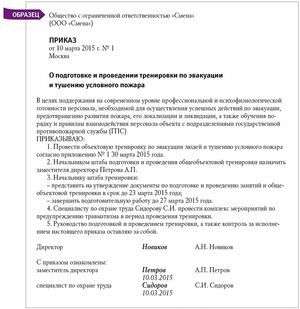
What is the order of evacuation in the fire?
When a fire is detected, it is necessary to immediately cause fire and rescuers by phone 101 or 112. The call to number 112 is possible from a mobile phone even in the absence of a SIM card. You need to report the exact address and floor and, if possible, send someone to meet the division.
The rate of fire spread is very high. Therefore, you need to close the door to the room where the fireplace is located. It is necessary to report to the head of the organization about the fire and begin evacuation in accordance with the evacuation plan, which should be on each floor. With a strong smoke, the means of protecting the respiration organs from carbon monoxide should be used: cottage-gauze dressings, moistened with a scarlet water.
The evacuation plan is worked out annually. For this, the order of the head, who are prescribed by persons responsible for conducting evacuation. To prevent panic, the announcement of the beginning of the evacuation should not contain the words "fire", "accident". It should be announced that for technical reasons the administration asks for workers and visitors to leave the premises.
Having heard alarm about the fire, people should immediately get out of the building and gather out on the street. Place of collection is determined in advance, usually the site near the building. If a person came out of the building unnoticed, he must necessarily report to himself in the yard to avoid unnecessary search.




